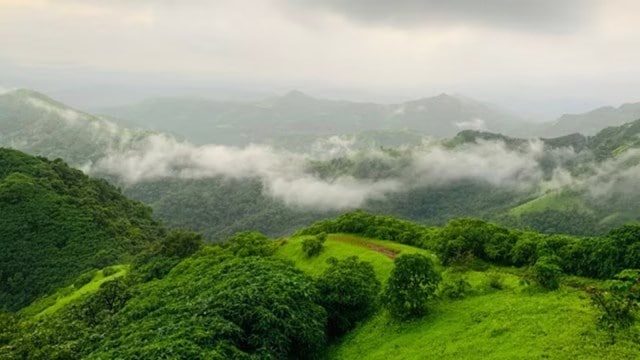Click here to join Express Pune WhatsApp channel and get a curated list of our stories
Pune research team conducts first-ever study of vegetation on Western Ghats cliffs
Smrithy Vijayan, a plant ecology researcher from the Agharkar Research Institute (ARI) in Pune was studying the plant communities on the basalt cliff faces of the Western Ghats when she came across the interesting resurrection or rehydrating plants. “These plants on cliffs can lose 90-95 per cent of their water in the dry period and […]
 The Western Ghats have different types of rock types but this team chose to work on basalt cliffs that spans only on the south of Gujarat, entire Maharashtra, north of Goa and Karnataka. (Express File)
The Western Ghats have different types of rock types but this team chose to work on basalt cliffs that spans only on the south of Gujarat, entire Maharashtra, north of Goa and Karnataka. (Express File) Smrithy Vijayan, a plant ecology researcher from the Agharkar Research Institute (ARI) in Pune was studying the plant communities on the basalt cliff faces of the Western Ghats when she came across the interesting resurrection or rehydrating plants. “These plants on cliffs can lose 90-95 per cent of their water in the dry period and still survive, only to regain or re-hydrate, sometimes in less than an hour, when water is available,” she says.
She and her team tried experiments on such plants, finding their water content in wet and dry periods and also using time lapse. “It was very interesting to observe how, within a certain time span, these plants could become dehydrated and enter into a dormant stage and, then, become re-hydrated,” she says.
With Smrithy as the lead researcher, the team studied 39 locations of the Western Ghat basalt cliffs, spanning altitudes of 100 m to 1300 m, and documented 231 plant species that are found there. They classified these plants into nine types according to their diversity in their function or adaptation to an extreme harsh condition.
“Another interesting find was that a large part of basalt cliffs are covered with the abundance of carnivorous plants, the Utricularia striatula and Utricularia graminifolia. Known as Bladderwort in common language, growing on a nutrient deficient surface, these plants have bladders in their roots that are very minute that capture and digest insects and microorganisms to derive nutrients,” says Smrithy. “Another plant type called legumes are plenty on cliffs that have nodules in their roots, through which they fix atmospheric nitrogen for themselves and also distribute it to other species nearby”, she adds.
There are many interesting plant species that escape and tolerate the extreme conditions that Smrithy and her team studied over four years of fieldwork in the northern Western Ghats.
The team, which include Aboli Kulkarni, Rohan Shetti, lead scientists of The Green Concept, Institute for Carbon Assessment and Restoration Ecology, Bhushan Shigwan, botanist with Oikos-Pune and Mandar Datar, scientist of ARI, Pune – have released the findings in the paper, “Floristic composition and plant functional type diversity of the basalt cliffs of Western Ghats, India”.
“The general perspective is that rocky habitats are barren and neglected habitats, as people are more interested in studying fertile and productive ecosystems. Since this was the first such study in India, we wanted to see how plants are thriving on a unique vertical habitat, the pattern of vegetation and how it is distributed with respect to the current environment. There are many challenges we had to face to do this work since there was no reference,” says Smrithy.
“We found that with an increase in the altitude, the plant diversity patterns were changing according to the availability in rainfall and sun exposure or temperature. Plants that could tolerate the extreme heat, and situations of little or no water, are dominating higher altitude drier cliffs while plants that depend on water sources are dominating on the cliffs in the low and middle altitudes”, she adds.
The Western Ghats have different types of rock types but this team chose to work on basalt cliffs that spans only on the south of Gujarat, entire Maharashtra, north of Goa and Karnataka.
“Where we carried out our work, we found many rare, endangered and endemic plants that are not known to others,” says Smrithy. She adds that the rocky outcrops are “ rich in plant diversity, and the species are highly important, in medicinal, ecological and economic ways”. “People don’t know about it. We wanted to increase the knowledge about this kind of habitat, its fertility and natural qualities and whether efforts should be made to conserve this,” says the researcher.
Click here to join Express Pune WhatsApp channel and get a curated list of our stories








